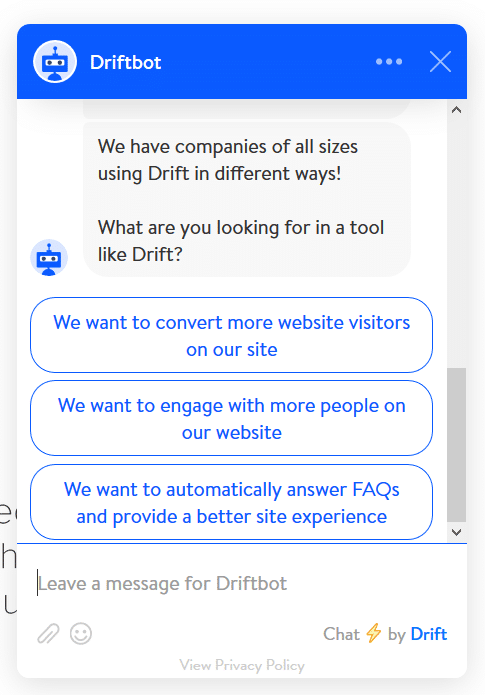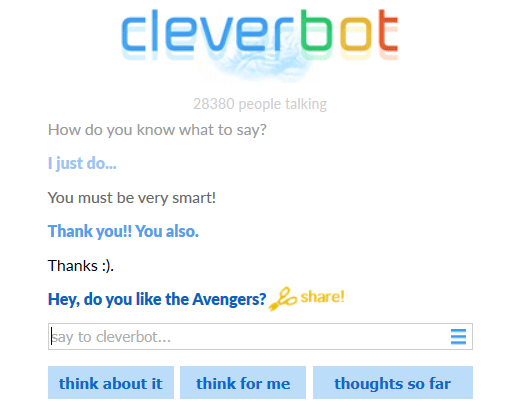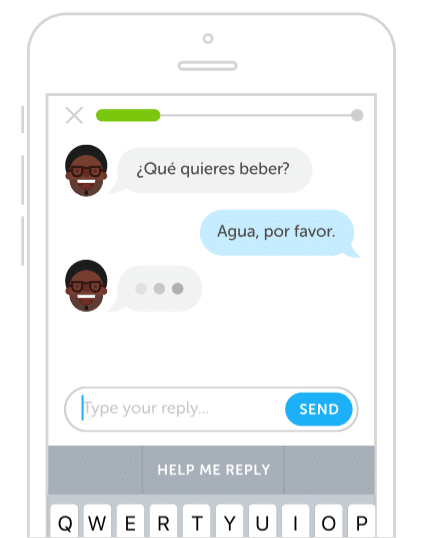The rise of the chatbot.
It used to be that messenger apps did just that one thing – message. And when a person needed to contact customer service, they either phoned in or sent an email, outlining their problem or complaint.
Even as live chat began to emerge on websites of all kinds (business, hobby, or nonprofit), people were limited to the type of interactions they could have. After all, unless a person is manning the live chat service 24/7 (which does happen, but not all the time), customers needing help were at the mercy of the chat hours.
But all of that is changing with new technological advances, primarily AI.
As artificial intelligence (AI) advances, and people begin to demand more from the organizations they do business with, new, more effective ways of communicating have begun to develop.
And one such method of staying in touch with people is through the use of chatbots.
Websites, mobile apps, and messenger systems like WhatsApp, Slack, Skype, and Facebook Messenger have all begun to embrace this new technology in an effort to build stronger relationships with their audiences.
But what are chatbots and what do they bring to the online landscape that other forms of communication don’t?
Better yet, how can you use chatbots within your organization to reach more people, offer better customer service, and give people a unique experience they aren’t likely to forget?
If these are questions you ask yourself and you wonder how you might utilize them for your website, keep reading.
What Are Chatbots?
A chatbot is an artificial intelligence software that can conduct conversations with people through messaging systems, mobile apps, and websites.
They are designed to help solve tasks when real live humans aren’t available. They may also help you to find more information during the early phases of your research.
A chatbot can answer questions, direct you to relevant content, help with making purchases, set and confirm appointments, send money, contact physical businesses, and much more.
There are two types of chatbots on the market today:
Simple Chatbots
These work based on pre-written keywords people enter when they have a question. If the keyword is not in the user’s question, the chatbot doesn’t understand and replies with a pre-set response such as “Sorry, I didn’t understand,” or in this case, “Does not compute.”

Oftentimes these types of chatbots will have specific choices users can pick from to direct the conversation, such as the ones offered by this Drift chatbot.
If a person needs something that goes beyond the scope of the predetermined responses, they are sometimes out of luck and need to make contact in other ways to get their questions asked.
Smart Chatbots
Though simple chatbots usually get the job done, smart chatbots are on the rise. Instead of relying on user keywords and pre-set responses, smart chatbots, such as Mitsuku, can have full-fledged conversations with you.
The more you talk to her, the smarter she becomes, integrating information such as your name when provided. And while this chatbot provides nothing more than social interaction, you can see how smart this technology is and the potential it holds.
To top it off, smart chatbots store conversations so you can use them for later analysis. This way you can make better data-driven decisions and improve the overall chatbot experience by evaluating conversations people are having with your chatbot.
What Are the Benefits of Using Chatbots?
No matter what kind of business or organization you operate, chatbots offer many benefits:
- Save time and money by automating customer support.
- Collect information about your target audience and use that data to then make improvements.
- Offer immediate responses to those with questions with a 100% response rate.
- Provide the 53% of people that would rather message customer service than call a way to get in touch.
- Speed up the buying process and secure more sales (including upsells and cross-sells).
- Direct users to the actual humans that can help them based on their chatbot interactions.
- Create customer loyalty by giving them an experience they’ll remember.
- Personalize the user’s experience, boost customer satisfaction, and increase conversions rates.
Interest in chatbots has grown exponentially over the past five years.
As interest grows more people than ever are searching “chatbots” in an effort to find out what they were, how they worked, and what they offered to those with an online or mobile presence.
And since it’s estimated that by 2020, 85% of all customer interactions will be without human interaction, it’s probably a good idea you look into them too if you haven’t already.
Creative Ways to Use Chatbots for Your Organization
People are motivated to use chatbots, whether simple or smart, for many reasons.
While the most common to start are that, they want quick answers to questions 24/7, want to resolve problems or complaints, or want to be directed to someone who can help the moment they need it.
But chatbots have the potential to do more than provide stellar customer service.
They can entertain people when they’re bored or lonely and perform tasks for people without them having to make a phone call.
In short, chatbots make people’s lives easier and more fun by not only providing helpful information but also compliments and casual outlets for small talk, kind of like this Cleverbot chatbot:
If you’re thinking about incorporating chatbots into your organization, check out these creative ways others are using this advanced technology to connect with their target audiences and get inspired.
1. Engage Users in a Creative Way
As new technology emerges, people are naturally drawn to it. They want to see how it works and what it can offer them. And if the technology is engaging and fun, that’s just an added bonus.
Chatbots can be informative and fun all at the same time. And depending on the channel you use for your chatbot, the creative options are endless.
Take for example what Domino’s does for its customers. You can confirm your pizza order on Twitter using a simple hashtag or a pizza emoji. The Dominos chatbot then responds and ensures you that your pizza is on the way.
The same goes for text messaging. Text a pizza emoji and let Dominos confirm your order.
Haven’t set up an account with them yet?
Your chatbot will let you know exactly what you have to do to take advantage of this creative interaction.
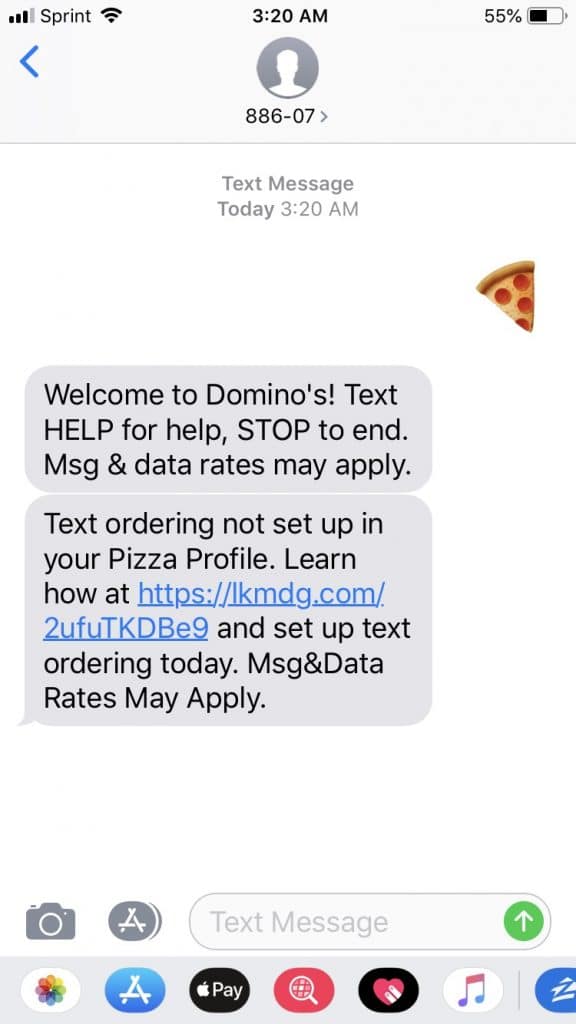
Sure, traditional order confirmations via email or on the website itself do the same thing. But people are more likely to remember the experience of sending an emoji for confirmation, and be encouraged to do it again because it’s fun.
And sometimes, when you’re trying to gain an edge against the competition, these are the methods you need to try to secure more customers.
2. Make Things Easier on Customers
Making things easier on your customers is important. Consumers are thought to wait 4 hours max for a response from customer support before they give up and go elsewhere.
But the average response time for most businesses is nearly 10 hours.
If your customer response times are not within the 4 hour time frame, you’re not doing yourself any favors. However, by at least initiating contact with customers using a chatbot, people will be more likely to wait for human interaction if it’s needed.
Give people a reason to forgo scrolling through distracting websites looking for phone numbers, addresses, waiting for responses, and more.
Instead, do what Fandango does and make things simple for people:
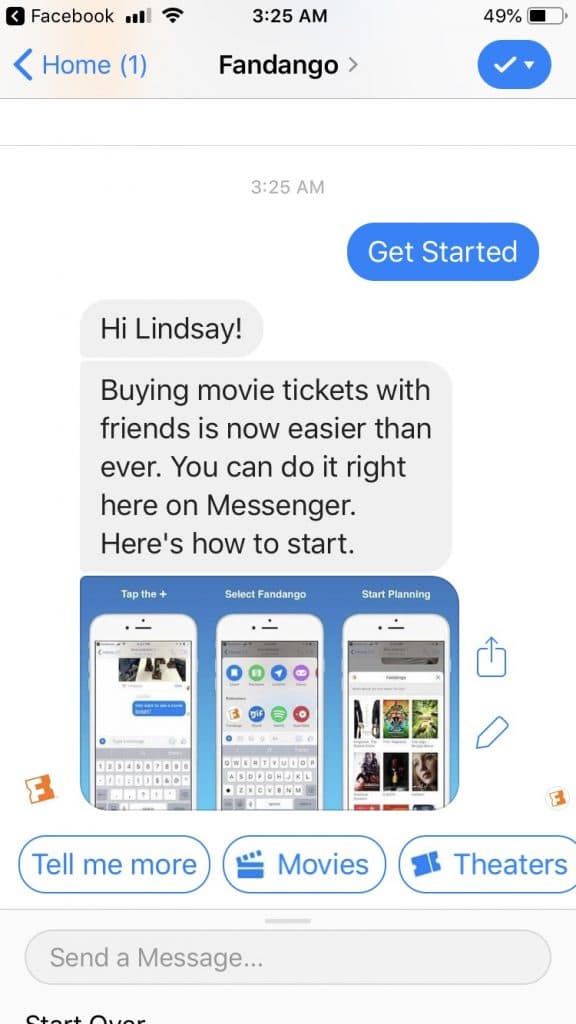
Using a Facebook Messenger chatbot, Fandango makes learning about movies, finding theaters, and picking movie times a cinch.
This is way better for mobile users (and a whole lot faster) than scouring the Fandango website in search of movies.
3. Provide Information and Secure Sales
Sometimes when you run an online business you need new and innovative ways to collect and convert high-quality leads.
And sometimes, interacting with people on different channels such as Skype or social media is the best way to do it.
Take for example Hipmunk, a business that makes planning your next vacation as easy and painless as possible.
Again, rather than force people to search through their website looking for travel accommodations, Hipmunk makes getting travel advice, searching flights, and booking hotels super simple on Skype by providing quick links, including the starting prices, to popular places like Paris France or London England.

Want another example? Check out what 1800-Flowers is doing with their Facebook Messenger chatbot to help you shop and order without ever leaving Facebook Messenger.
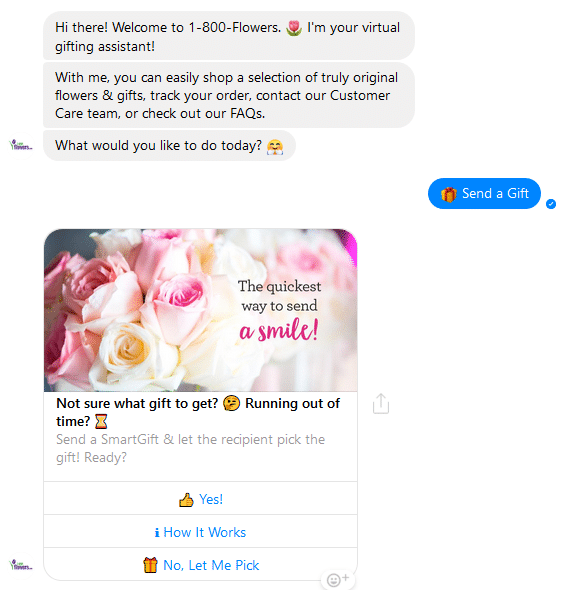
The thing that makes 1-800-Flowers stand out (besides the fact that their chatbot makes it so you never have to call them again!) is that they use a chatbot to have natural, lighthearted, and fun conversations with prospective customers.
They use emojis, and have a conversational tone, and pre-set options making it easy to find the information you need and purchase the flowers you want.
This approach has been very successful for them. In fact, their president Chris McCann claims that nearly 70% of the company’s bot orders are from new customers. That’s a lot of business to generate from a simple chatbot found on Facebook.
4. Gather Information
Chatbots don’t always have to be used to generate leads or secure more sales. With a cloud-based solution designed to gather information from chatbot conversations, your organization can learn some very valuable information.
For instance, this fully accessible chatbot by Endurance for dementia patients aims to track and monitor conversations patients have to help better diagnose their conditions. It even comes with voice access for those that are hard of seeing.
All interactions are recorded so physicians, family members, scientists, researchers, and caregivers can better understand how Alzheimer’s is affecting someone’s brain.
6. Initiate Change
Do you run a nonprofit organization and want to spur change in your community?
If so, model your chatbot off U-Report, which creates large scale text polls presented by chatbots for people to take so they can voice their opinions on a variety of subjects.
Real-time responses and feedback collected from chatbot interactions are used to educate the masses and fuel new policies. Polls revolve around urgent social issues such as health, education, water, sanitation and hygiene, youth unemployment, HIV/AIDS, and disease outbreaks.
People want to feel they’re making a difference and that their voices are being heard. And the same can be done with your constituents. Give people an easy way to express their opinions, voice their concerns, and spur change using advanced technology like chatbots.
7. Educate People
The great thing about chatbots are that the more you use them, the smarter they get.
And when it comes to educating people, chatbots are a non-intrusive, simple way to engage with people that might be hesitant to learn a new skill in front of actual people.
At least that’s what the people at Duolingo believe. And it seems they’re on to something.
With the Duolingo app chatbot, you can have a conversation with a chatbot as you learn a new language, without fear of being judged for your mistakes.
And since the technology is so advanced, as you progress in learning your new language, the chatbot adjusts so you can continue to learn.
Pinpointing your audience’s pain point, such as wanting to learn something but wanting an alternative way to do so, and providing a simple solution, is an effective way to grow your following or business.
8. Deliver Content
If you run a website that regularly publishes content, and you want to make sure your readers not only know when there’s new content available, but receive the content they want to read, get inspired by TechCrunch’s content delivery chatbot.

Forget making readers scour the internet for their favorite news stories.
Instead, give people the option to choose how often they want to receive content and what topics they’re interested in. And personalize the experience by using artificial intelligence to deliver related content based on the stories people interact with most.
This method of content delivery goes beyond what email marketing can do. It creates a positive brand experience, drives traffic to your site, and shows readers you care about the content they want to read.
Final Thoughts
In truth, the options are endless when it comes to how you can use chatbots to interact with people. After all, you’re in charge of building your chatbot from the ground up. Choosing how it engages with people, the options it presents people when they initiate a conversation, and how smart it will be is all up to you.
But one thing you can be sure of, is that as technology continues to advance in the field of ai, chatbots are sure to become a staple method for connecting with people that are interested in what you have to offer.
If you’re thinking about launching a chatbot on your website, or possibly creating an app chatbot for your target audience, get in touch with us first.
We can help ensure your website design and user experience is suitable for leads that use your chatbot, market your brand so you reach a broader audience, and even track user behavior once your chatbot goes live.
chatbot customer serviceYou May Also Like

Having a website is an absolute necessity for any business. Gone are the days when you could simply update your website once and forget about it for months on end. In today’s ever-changing digital landscape it is important to constantly track and measure how well your website performs, as well…
read more >
Thomas Bertram (T. Bert) Lance famously said, "If it ain't broke, don't fix it." Unfortunately, T. Bert Lance couldn’t foresee the future. He didn’t know that over 94% of Americans would be on the internet by 2024. If your website doesn't receive periodic updates or isn't accessible, users can become…
read more >
